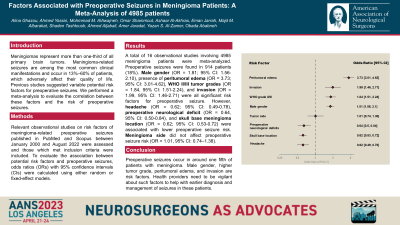Factors Associated with Preoperative Seizures in Meningioma Patients: A Meta-Analysis of 4985 patients
Factors Associated with Preoperative Seizures in Meningioma Patients: A Meta-analysis of 4985 Patients
Friday, April 21, 2023

.jpg)
Alina Ghazou (she/her/hers)
Medical Student
Jordan University of Science and Technology
ePoster Presenter(s)
Introduction: Meningiomas represent more than one-third of all primary brain tumors. Meningioma-related seizures are among the most common clinical manifestations and occur in 13%–60% of patients, which adversely affect their quality of life. Previous studies suggested variable potential risk factors for preoperative seizures. We performed a meta-analysis to evaluate the correlation between these factors and the risk of preoperative seizures.
Methods: Relevant observational studies on risk factors of meningioma-related preoperative seizures published in PubMed and Scopus between January 2000 and August 2022 were assessed and those which met inclusion criteria were included. To evaluate the association between potential risk factors and preoperative seizures, odds ratios (ORs) with 95% confidence intervals (CIs) were calculated using either random or fixed-effect models.
Results: A total of 16 observational studies involving 4985 meningioma patients were meta-analyzed. Preoperative seizures were found in 914 patients (18%). Male gender (OR = 1.81; 95% CI: 1.56-2.10), presence of peritumoral edema (OR = 3.73; 95% CI: 3.01-4.62), WHO II/III tumor grades (OR = 1.84, 95% CI: 1.51-2.24), and invasion (OR = 1.99, 95% CI: 1.46-2.71) were all significant risk factors for preoperative seizure. However, headache (OR = 0.62; 95% CI: 0.49-0.78), preoperative neurological deficit (OR = 0.64, 95% CI: 0.50-0.84), and skull base meningioma location (OR = 0.62; 95% CI: 0.53-0.72) were associated with lower preoperative seizure risk. Meningioma side did not affect preoperative seizure risk (OR = 1.01, 95% CI: 0.74–1.38).
Conclusion : Preoperative seizures occur in around one fifth of patients with meningioma. Male gender, higher tumor grade, peritumoral edema, and invasion are risk factors. Health providers need to be vigilant about such factors to help with earlier diagnosis and management of seizures in these patients.
Methods: Relevant observational studies on risk factors of meningioma-related preoperative seizures published in PubMed and Scopus between January 2000 and August 2022 were assessed and those which met inclusion criteria were included. To evaluate the association between potential risk factors and preoperative seizures, odds ratios (ORs) with 95% confidence intervals (CIs) were calculated using either random or fixed-effect models.
Results: A total of 16 observational studies involving 4985 meningioma patients were meta-analyzed. Preoperative seizures were found in 914 patients (18%). Male gender (OR = 1.81; 95% CI: 1.56-2.10), presence of peritumoral edema (OR = 3.73; 95% CI: 3.01-4.62), WHO II/III tumor grades (OR = 1.84, 95% CI: 1.51-2.24), and invasion (OR = 1.99, 95% CI: 1.46-2.71) were all significant risk factors for preoperative seizure. However, headache (OR = 0.62; 95% CI: 0.49-0.78), preoperative neurological deficit (OR = 0.64, 95% CI: 0.50-0.84), and skull base meningioma location (OR = 0.62; 95% CI: 0.53-0.72) were associated with lower preoperative seizure risk. Meningioma side did not affect preoperative seizure risk (OR = 1.01, 95% CI: 0.74–1.38).
Conclusion : Preoperative seizures occur in around one fifth of patients with meningioma. Male gender, higher tumor grade, peritumoral edema, and invasion are risk factors. Health providers need to be vigilant about such factors to help with earlier diagnosis and management of seizures in these patients.
